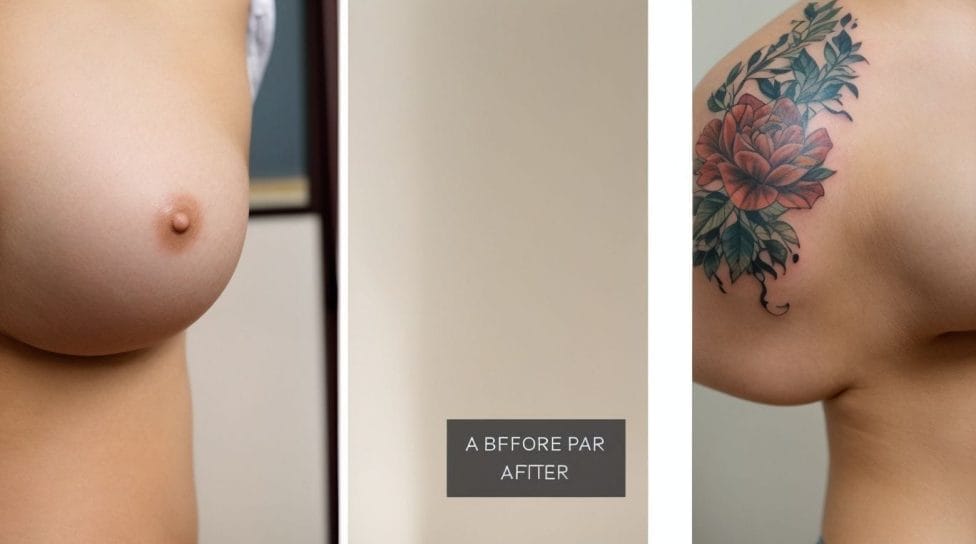Losing weight is a significant achievement that many people strive for, but have you ever wondered what happens to your tattoos when you shed those pounds? Weight loss can indeed impact tattoos, and it’s important to understand how these changes may occur.
In this article, we will explore the effects of weight loss on tattoos and discuss factors that influence these changes. We will also provide tips for preserving tattoos during weight loss and address whether a tattoo touch-up or removal is necessary after losing weight.
When it comes to tattoos and weight loss, several questions arise. Does the size of the tattoo change? Does the placement of the tattoo change? Does the appearance of the tattoo change? These are all valid concerns that we will address in detail.
Furthermore, we will explore the factors influencing tattoo changes during weight loss. The amount and rate of weight loss, the location of the tattoo, and the skin’s elasticity all play a role in how tattoos may be affected.
To ensure the preservation of your tattoos during weight loss, we will provide helpful tips. These tips include maintaining a steady and healthy weight loss, staying hydrated, moisturizing the skin, and protecting the tattoo from sun exposure.
Lastly, we will discuss whether tattoo touch-up or removal may be necessary after weight loss. We will identify when to consider a tattoo touch-up and when tattoo removal may be a suitable option.
By understanding the effects of weight loss on tattoos and implementing the right strategies, you can ensure the longevity and appearance of your tattoos even as your body changes.
Key takeaways:
- Tattoos may change when you lose weight: The size, placement, and appearance of tattoos can be affected by weight loss.
- Factors influencing tattoo changes: The amount and rate of weight loss, tattoo location, and skin elasticity are important factors in determining how tattoos may be affected during weight loss.
- Tips for preserving tattoos during weight loss: Maintaining a steady and healthy weight loss, staying hydrated and moisturizing the skin, and protecting tattoos from sun exposure can help preserve their appearance.
How Does Weight Loss Affect Tattoos?

Photo Credits: Tattooineplanet.Com by Keith Mitchell
When you lose weight, it can have an impact on your tattoos. How does weight loss affect tattoos? Well, the effect of weight loss on tattoos depends on various factors, such as the location, the elasticity of your skin, and the amount of weight lost. Generally, tattoos may become distorted or appear stretched if the skin in the area loses its elasticity. This is not always the case, and some individuals may notice no significant changes in their tattoos after weight loss. It’s important to remember that everyone’s experience may vary, so it’s best to consult with a professional tattoo artist for personalized advice.
Does the Size of the Tattoo Change?
The size of a tattoo can change during weight loss, although the extent of the change varies among individuals. When losing weight, fat cells shrink, which can cause the skin to tighten, leading to a reduction in the tattoo’s size. This change is typically minimal and may not be noticeable. Factors such as the amount and rate of weight loss, as well as skin elasticity, can influence how much the tattoo size changes. It’s important to note that each person’s experience is unique, and some individuals may not see any significant changes in the size of their tattoos after weight loss.
Does the Size of the Tattoo Change?
True story: Sarah, who lost 50 pounds, noticed a slight decrease in the size of her tattoo due to the tighter skin. The change was minimal and did not affect the overall appearance or meaning of her tattoo. She was pleased with the results and embraced her transformed body and cherished tattoo.
Does the Placement of the Tattoo Change?
The placement of a tattoo may change when you lose weight. As you lose weight, the shape and size of your body can change, which can affect how the tattoo looks. If the tattoo was originally placed in an area with more fat or muscle, it may stretch or distort as the body shrinks. Similarly, if the tattoo was placed in an area that becomes more prominent after weight loss, it may look different than when it was first done. It’s important to consider how weight loss may impact the placement and appearance of your tattoo. Does the placement of the Tattoo Change?
Does the Appearance of the Tattoo Change?
When you lose weight, it can affect the appearance of your tattoos. Do the changes in the appearance of tattoos during weight loss depend on various factors?
1. Size of the Tattoo: The tattoo’s size may change as the skin stretches or contracts with weight loss.
2. Placement of the Tattoo: Does the tattoo’s placement also play a role? If the tattoo is on an area with significant weight loss, it may become distorted or warped.
3. Skin Elasticity: Does the elasticity of your skin affect how it responds to weight loss? If your skin is less elastic, the tattoo may appear more stretched or wrinkled.
To minimize changes, maintain a healthy weight loss, and moisturize and protect your skin. If significant changes occur, a tattoo touch-up or removal may be necessary.
Factors That Influence Tattoo Changes During Weight Loss

Photo Credits: Tattooineplanet.Com by Raymond Young
When it comes to losing weight, have you ever wondered what happens to your tattoos? In this section, we’ll dive into the fascinating factors influencing how tattoos change during weight loss. From the amount and rate of weight loss to the location of the tattoo and even the elasticity of your skin, we’ll uncover the intriguing dynamics behind these transformations. Get ready to uncover the secrets that your ink holds as your body goes through its transformative journey.
Amount and Rate of Weight Loss
| Amount and Rate of Weight Loss | Effects on Tattoos |
| Significant | Tattoos may stretch, distort, or become uneven as the skin shrinks rapidly. |
| Gradual | Tattoos may appear more defined and enhanced as the skin gradually tightens. |
| Minimal | Tattoos generally remain unaffected as long as the skin remains unchanged. |
The amount and rate of weight loss can have a significant impact on tattoos. It is essential to understand how weight loss affects tattoos to make informed decisions.
When there is a significant and rapid weight loss, tattoos may stretch, distort, or become uneven as the skin shrinks rapidly. The sudden changes in body composition can impact the appearance of tattoos.
On the other hand, if the weight loss is significant but gradual, tattoos may appear more defined and enhanced as the skin gradually tightens. The gradual tightening of the skin can bring out the details of the tattoo, making it look more prominent.
When the weight loss is minimal, tattooed areas generally remain unaffected as long as the skin remains unchanged. However, it is crucial to note that individual experiences may vary, and factors such as skin elasticity and tattoo placement also contribute to the overall outcome of weight loss on tattoos.
If you undergo significant weight loss and notice changes in your tattoos, there are a few options to consider. Some individuals may choose to have touch-ups to refine their tattoos after weight loss, aiming to restore the original appearance. On the other hand, others may be dissatisfied with the final appearance and consider tattoo removal. The best action should be taken after consulting with a professional tattoo artist or dermatologist who can assess individual circumstances and provide guidance.
Location of the Tattoo
The location of a tattoo plays a crucial role in how it is affected by weight loss. Tattoos in areas with less fat, such as the hands or feet, have a higher chance of stretching and distortion as weight is lost. On the other hand, tattoos in areas with more fat, like the thighs or abdomen, may undergo less noticeable changes during weight loss. Additionally, areas with looser skin, such as the upper arms or stomach, might experience more significant alterations in the appearance of the tattoo. Therefore, it is important to consider the location of your tattoo when determining weight loss goals and considering possible touch-ups or removal.
Skin Elasticity
Skin elasticity is a crucial factor in tattoo changes during weight loss. It determines how well the skin can adapt to changes in body size and shape. To illustrate this, consider the following table that showcases the impact of skin elasticity on tattoos during weight loss:
| High Skin Elasticity | Minimal tattoo distortion or stretching |
| Medium Skin Elasticity | Slight distortion or stretching of the tattoo |
| Low Skin Elasticity | Potentially significant distortion or stretching of the tattoo |
Skin elasticity is influenced by age, genetics, and overall skin health. Historically, cultures worldwide have valued tattoos for their ability to adapt and morph with the body, making them an enduring form of self-expression.
Tips for Preserving Tattoos During Weight Loss

Photo Credits: Tattooineplanet.Com by Daniel Hall
When shedding those extra pounds, have you ever wondered what happens to your tattoos? In this section, we’ll explore some valuable tips for preserving your ink during weight loss journeys. From maintaining a steady and healthy weight loss to staying hydrated and moisturizing your skin, we’ll cover it all. Plus, we’ll dive into the importance of protecting your tattoo from harmful sun exposure. Get ready to rock your body transformation while keeping your tattoos vibrant and beautiful!
Maintain a Steady and Healthy Weight Loss
To maintain a steady and healthy weight loss while preserving your tattoos, follow these steps:
- Set realistic goals to maintain a steady and healthy weight loss and prevent rapid weight fluctuations that can affect your tattoos.
- Eat a balanced diet that promotes maintaining a steady and healthy weight loss. Focus on consuming nutritious foods and avoid crash diets leading to muscle loss and saggy skin.
- Exercise regularly to maintain a steady and healthy weight loss. Incorporate cardiovascular exercises and strength training to build muscle, which helps improve skin elasticity.
- Stay hydrated to maintain a steady and healthy weight loss. Drink an adequate amount of water daily to keep your skin hydrated and prevent dryness or cracking.
- Moisturize your skin to maintain a steady and healthy weight loss. Apply a quality tattoo-friendly moisturizer regularly to keep your skin healthy and supple.
- Avoid excessive sun exposure to maintain a steady and healthy weight loss. Protect your tattoos from harmful UV rays using sunscreen with a high SPF and wearing protective clothing.
- Monitor your weight loss progress to maintain a steady and healthy weight loss. Track your weight loss journey and adjust your routine to ensure a gradual and sustainable weight loss.
Stay Hydrated and Moisturize the Skin
Staying hydrated and moisturizing the skin is crucial for preserving tattoos during weight loss. Here are a few valuable tips to achieve this:
- Ensure proper hydration by drinking plenty of water, which will keep your skin moisturized from the inside out.
- To prevent dryness and flakiness, apply a high-quality moisturizer designed for tattoos daily.
- Avoid exposing your tattooed skin to hot showers or baths, as they can strip away its natural oils.
- To safeguard your tattoo from excessive sun exposure, always apply sunscreen with a high SPF.
- Do not use harsh soaps or cleansers on the area where your tattoo is located.
By adhering to these suggestions, you can ensure that your tattoo remains vibrant and in optimal condition while losing weight.
Protect the Tattoo from Sun Exposure
Protecting your tattoo from sun exposure is crucial to maintain its vibrant colors and prevent fading. Here are some tips to protect the tattoo from sun exposure and shield it from the harmful effects of the sun:
- Apply sunscreen: Use a broad-spectrum sunscreen with a high SPF on your tattoo, ensuring complete coverage.
- Cover-up: When spending extended periods in the sun, wear loose clothing or a lightweight cover-up to protect the tattoo from sun exposure.
- Seek shade: Avoid direct sunlight as much as possible, especially during peak hours when the sun’s rays are strongest.
- Moisturize: Keep your tattoo moisturized with an SPF-containing lotion to maintain hydration and vibrancy.
- Avoid tanning beds: Intense UV exposure from tanning beds can cause your tattoo to fade quickly.
Is Tattoo Touch-up or Removal Necessary after Weight Loss?

Photo Credits: Tattooineplanet.Com by Jason Moore
Losing weight can bring about exciting transformations, but have you ever wondered about the fate of your tattoos? In this section, we’ll dive into tattoo touch-ups and removal after weight loss. Discover when and why you might want to consider a touch-up to freshen up your ink and bring it back to life. We’ll explore the circumstances that may lead you to contemplate tattoo removal, allowing you to make an informed decision about the future of your body art.
When to Consider Tattoo Touch-up
When considering tattoo touch-ups after weight loss, there are a few factors to consider.
- Significant change in size: If your tattoo has stretched or distorted due to weight loss, it may be a good idea to consider a touch-up to restore its original appearance.
- Fading or color change: Weight loss can cause tattoos to fade, or the colors may appear different. If the vibrancy of your tattoo has significantly decreased, a touch-up can bring back its original look.
- Uneven lines or blurry details: If weight loss has caused the lines of your tattoo to become uneven or the details to blur, a touch-up can sharpen the lines and enhance the overall clarity of the design.
It is important to consult with a professional tattoo artist to assess the specific changes to your tattoo and determine if a touch-up is necessary.
When to Consider Tattoo Removal
When to Consider Tattoo Removal
When considering tattoo removal after weight loss, you should consider a few key factors. If you have experienced significant weight loss and your tattoo has become distorted or stretched, it may be necessary to consider removal. Additionally, if the tattoo no longer aligns with your new body shape or you simply no longer resonate with the design, removal may be a good option for you. It’s crucial to consult with a professional tattoo removal specialist who can assess the tattoo and provide guidance on the best course of action.
Tattoo removal methods have significantly evolved over the years. Previously, tattoo removal involved painful techniques like sanding or cutting off the skin. Fortunately, technological advancements have given us safer and more effective methods, such as laser tattoo removal. Laser technology works by breaking down the tattoo ink into smaller particles, which are then naturally eliminated by the body. Therefore, if you find yourself in a situation where tattoo removal is necessary, rest assured, knowing that modern methods can help you achieve the desired results.
Some Facts About What Happens to Tattoos When You Lose Weight:
- ✅ Rapid weight loss or gain can affect the appearance of tattoos. (Source: authoritytattoo.com)
- ✅ Tattoos are not as flexible as the skin, so that they may distort after weight loss. (Source: authoritytattoo.com)
- ✅ Areas prone to tattoo distortion after weight loss include the belly, upper arms, and thighs. (Source: authoritytattoo.com)
- ✅ Smaller tattoos are more affected by weight loss and may be difficult to correct. (Source: authoritytattoo.com)
- ✅ Losing weight slowly can help keep tattoos intact and minimize distortion. (Source: byrdie.com)


